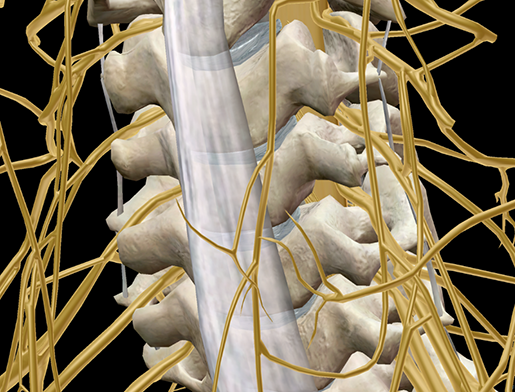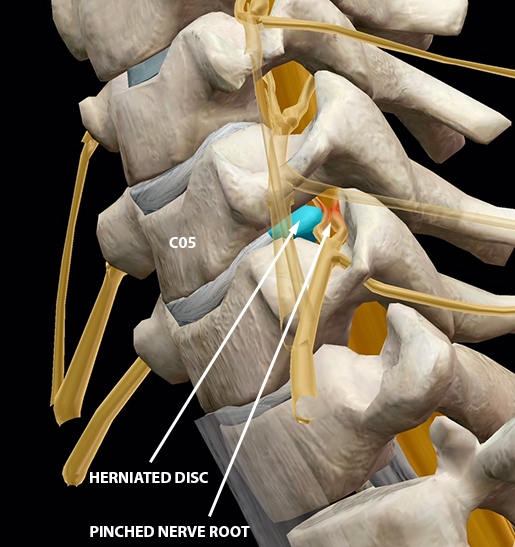Posted on 8/22/16 by Madison Oppenheim
No matter how many thousands of dollars you spend on plastic surgery or hours you spend in the gym doing squats, you can't stop the march of time. Everyone is afraid of getting older and the pain that comes with it: arthritis, herniated discs, and pinched nerves, to name a few.
Cervical radiculopathy, commonly known as a pinched nerve, affects 84 out of every 100,000 people per year and occurs when a spinal nerve root in the neck is compressed.
The "back bone" is actually a collection of 24 stacked vertebrae that protect your spinal cord from the daily disasters of life. The first 7 vertebrae comprise the cervical spine, a.k.a. your neck. Between each vertebra are intervertebral discs, which are flexible and composed of two parts: the annulus fibrosus—the flexible, tough outer ring—and the nucleus pulposus—the soft, pulpy, and highly elastic center. These discs are essential in absorbing shock in everyday movements, like when your friend calls your name from down the hall behind you and your neck snaps around to see who it is, or when "your song" comes on the radio and you bop your head up and down in the car.
 Image captured from Muscle Premium.
Image captured from Muscle Premium.
The spinal cord is like the body's message highway—relaying information from the brain to the peripheral nerves throughout your body. When your brain tells you to scratch that bug bite on your foot, the message travels down the spinal cord to your arm, which completes the action.
So we covered the cervical part - relating to your cervical spine, but where does the "radiculopathy" part come from? Radiculopathy is the disease of a nerve root, usually stemming from a pinched nerve. The pain caused by cervical radiculopathy is usually descibed as a burning or sharp pain that begins in the neck and travels down the arm. Other symptoms can include tingling or the feeling of "pins and needles" in the fingers or hand; weakness in the muscles of the arm, shoulder, or hand; and loss of sensation.
 Image captured from Muscle Premium.
Image captured from Muscle Premium.
A pinched nerve can occur from degenerative changes or an injury to a disc. As I mentioned above, no one is safe from the effects of aging, and as we get older our spine shrinks and can lose water content. This combination leads to a collapse of disc space, which creates bone spurs as the body tries to make up for the lost strength. Bone spurs can cause the foramen—small spaces between vertebrae for nerve roots to leave through—to narrow. These degenerative changes are also known as arthritis or spondylosis.
We've probably all heard the phrase "Grandpa's got a herniated disc" at one time or another, but what does that even mean? A herniated disc occurs when the nucleus pulposus (the soft center) pushes against the annulus fibrosus (the tough outer ring). If the disc bulges out toward the spinal canal, it applies pressure against the nerve root, causing pain.
The majority of patients with cervical radiculopathy get better over time and do not require treatment, although there are options available to relieve discomfort. One such option is a soft cervical collar: a padded ring that wraps around the neck and allows the muscles to relax and limits motion.
Physical therapy is another option that can help relieve pain and improve range of motion while also strengthening neck muscles.
There are also many medications including nonsteroidal anti-inflammatory drugs, oral corticosteroids, steroid injections, and narcotics that can improve symptoms.
If the nonsurgical teatment is not successful, surgery is also an option your doctor may recommend.
Although there is nothing we can do to prevent getting old and wrinkly and eating mushy food, you can prevent cervical radiculopathy from recurring by maintaining proper posture, continuing regular exercise, being mindful of unnecessary forces on your spine (stop spending your days scrolling through Facebook), and keeping a healthy weight.
Be sure to subscribe to the Visible Body Blog for more anatomy awesomeness!
Are you a professor (or know someone who is)? We have awesome visuals and resources for your anatomy and physiology course! Learn more here.
When you select "Subscribe" you will start receiving our email newsletter. Use the links at the bottom of any email to manage the type of emails you receive or to unsubscribe. See our privacy policy for additional details.
©2025 Visible Body, a division of Cengage Learning